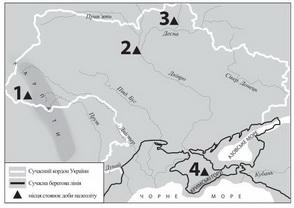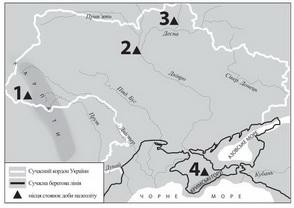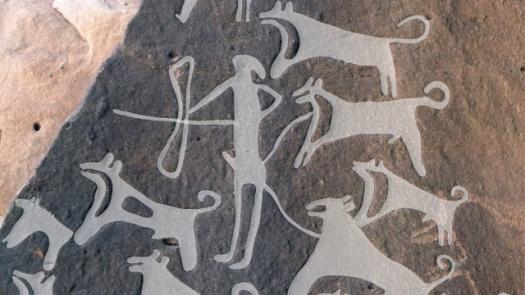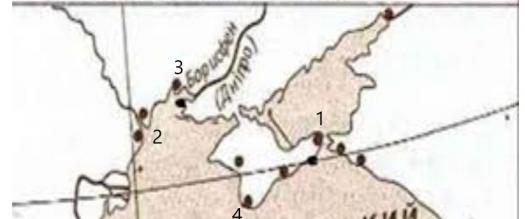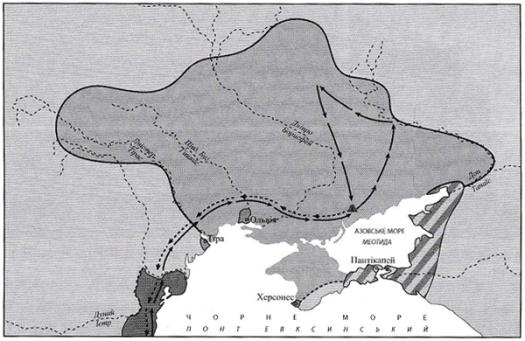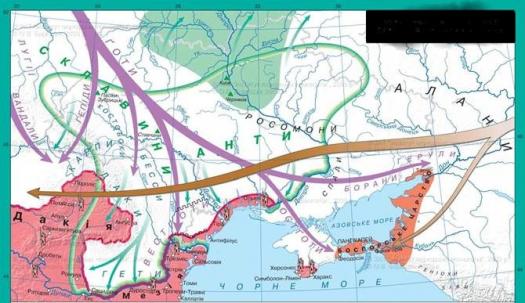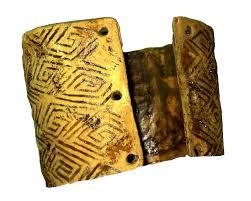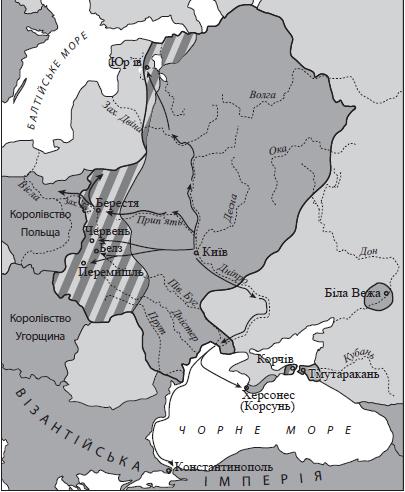Тест 1 з історії
(2).jpg)
- 1.
Якою цифрою на картосхемі позначено назву стоянки, де було знайдено неадертальське поховання?
- A.
1
- B.
2
- C.
3
- D.
4
Correct Answer
D. 4Explanation
The correct answer is 4.Rate this question:
-
- 2.
Якою цифрою позначена на картосхемі територія розселення середньостогівської археологічної культури?
- A.
1
- B.
2
- C.
3
- D.
4
Correct Answer
B. 2Explanation
The correct answer is 2.Rate this question:
-
- 3.
Вкажіть, у якому столітті сармати витіснили скіфів у Крим та за Дунай?
- A.
ІІІ ст. до н.е.
- B.
ІІІ ст. н.е.
- C.
І ст. до н.е.
- D.
V ст. н.е.
Correct Answer
A. ІІІ ст. до н.е.Explanation
In the given answer, it is stated that the Sarmatians displaced the Scythians in Crimea and beyond the Danube in the 3rd century BCE. This suggests that the Sarmatians were the dominant group in that region during that time period, and they were able to push the Scythians out of their territories. This answer aligns with historical accounts and archaeological evidence that indicate the Sarmatians gradually replaced the Scythians in these areas during the 3rd century BCE.Rate this question:
-
- 4.
Оберіть варіант, у якому представлено правильну послідовність кочових племен, які сусідили з давніми слов*янами?
- A.
авари-гуни-сармати
- B.
сармати-скіфи-авари
- C.
скіфи-сармати-гуни
- D.
гуни-сармати-авари
Correct Answer
B. сармати-скіфи-авариExplanation
The correct answer is "сармати-скіфи-авари" because the question asks for the correct sequence of nomadic tribes that were neighbors to the ancient Slavs. The Sarmatians were known to have lived in the same region as the ancient Slavs, followed by the Scythians, and then the Avars.Rate this question:
-
- 5.
Якою цифрою позначена на картосхемі стоянка доби раннього палеоліту?
- A.
1
- B.
2
- C.
3
- D.
4
Correct Answer
A. 1Explanation
The correct answer is 1.Rate this question:
-
- 6.
У який період стародавньої історії України було створене це зображення?
- A.
палеоліт
- B.
мезоліт
- C.
неоліт
- D.
ранній залізний вік
Correct Answer
B. мезолітExplanation
The correct answer is мезоліт, which translates to Mesolithic in English. The Mesolithic period is characterized by the transition from a nomadic lifestyle to a more settled one, with the development of agriculture and the domestication of animals. This period is typically associated with the development of more advanced tools and the emergence of early forms of art and culture. Therefore, it is likely that the image in question was created during the Mesolithic period in ancient Ukrainian history.Rate this question:
-
- 7.
Якою цифрою на картосхемі позначена столиця Боспорського царства?
- A.
1
- B.
2
- C.
3
- D.
4
Correct Answer
A. 1Explanation
The correct answer is 1. This suggests that the capital of the Bosporus Kingdom is represented by the number 1 on the map.Rate this question:
-
- 8.
Територію якої держави позначено на картосхемі штрихуванням?
- A.
Аварського каганату
- B.
Сарматії
- C.
Боспорського царства
- D.
Великої Скіфії
Correct Answer
C. Боспорського царстваExplanation
The correct answer is "Боспорського царства" because the question asks which state's territory is marked on the map with hatching, and the Bosporan Kingdom is the only option that fits this description. The other options, Avrasya Khaganate, Sarmatia, and Great Scythia, do not have any indication that their territories are marked on the map with hatching.Rate this question:
-
- 9.
Коли і яка подія відбулася, що позначена на картосхемі зеленими стрілками?
- A.
Велике переселення народів, 4-6 ст.
- B.
вторгнення гунів наприкінці 4 ст.
- C.
Велике розселення слов*ян, 5-7 ст.
- D.
аварська навала у 6 ст.
Correct Answer
C. Велике розселення слов*ян, 5-7 ст.Explanation
The correct answer is "Велике розселення слов*ян, 5-7 ст." This event refers to the migration and settlement of the Slavic people during the 5th to 7th centuries. The green arrows on the map indicate this event.Rate this question:
-
- 10.
До якого періоду стародавньої історії України належить зображена нижче пам*ятка?
- A.
неоліту
- B.
раннього палеоліту
- C.
пізнього палеоліту
- D.
мезоліту
Correct Answer
C. пізнього палеолітуExplanation
The correct answer is "пізнього палеоліту" (late Paleolithic). This is because the question is asking about the period of ancient history to which the depicted monument belongs. The late Paleolithic period refers to the final stage of the Stone Age, characterized by the development of more advanced tools and the emergence of early human artistic expression.Rate this question:
-
- 11.
Позначте народ, чиє поселення зображене на малюнку?
- A.
буго-дністровської археологічної культури
- B.
скіфів
- C.
трипільців
- D.
слов*ян
Correct Answer
C. трипільцівExplanation
The correct answer is "трипільців" because the image depicts a settlement belonging to the Trypillian culture. This culture existed in the region of modern-day Ukraine, Moldova, and Romania during the Neolithic and Copper Ages. The Trypillian culture is known for its large, well-organized settlements and distinctive pottery.Rate this question:
-
- 12.
Якою цифрою на картосхемі позначена держава, з якою пов*язують цю пам*ятку?
- A.
1
- B.
2
- C.
3
- D.
4
Correct Answer
A. 1 -
- 13.
Вкажіть, як називали греко-римські автори давні слов*янські племена?
- A.
анти
- B.
будини
- C.
склавини
- D.
венеди
Correct Answer
D. венедиExplanation
Greek-Roman authors referred to the ancient Slavic tribes as "венеди" in their writings.Rate this question:
-
- 14.
Вкажіть східнослов*янські племена, які є предками сучасних українців? (3 відповіді)
- A.
кривичі
- B.
деревляни
- C.
дреговичі
- D.
хорвати
- E.
полочани
- F.
уличі
Correct Answer(s)
B. деревляни
D. хорвати
F. уличіExplanation
The correct answer is деревляни, хорвати, уличі. These are the East Slavic tribes that are considered ancestors of modern Ukrainians. The Kryvichians, Dregovichs, and Polochans were also East Slavic tribes, but they are not included in the correct answer.Rate this question:
-
- 15.
Вкажіть ознаки трипільської цивілізації (3 відповіді)
- A.
будування великих поселень - протоміст
- B.
винайдення заліза
- C.
перехід до орного землеробства
- D.
перехід до кочового скотарства
- E.
наявність релігійного культу богині-матері
- F.
поклоніння богу вогню - Сварогу
Correct Answer(s)
A. будування великих поселень - протоміст
C. перехід до орного землеробства
E. наявність релігійного культу богині-матеріExplanation
The correct answer choices for the question are "будування великих поселень - протоміст," "перехід до орного землеробства," and "наявність релігійного культу богині-матері." These characteristics are associated with the Trypillian civilization. Trypillian settlements were known for their large size and complex architecture, indicating a highly developed society. The transition to agriculture and the cultivation of land marked a significant shift in their lifestyle. The presence of a religious cult centered around the goddess-mother suggests the importance of female deities in their belief system.Rate this question:
-
- 16.
Вкажіть ознаки, притаманні скіфському суспільству (3 відповіді).
- A.
ведення осілого способу життя
- B.
поклоніння верховному божеству - Зевсу
- C.
звіриний стиль у мистецтві
- D.
використання короткого меча - акінака
- E.
домінування матріархату
- F.
ведення кочового способу життя
Correct Answer(s)
C. звіриний стиль у мистецтві
D. використання короткого меча - акінака
F. ведення кочового способу життяExplanation
The correct answers are "звіриний стиль у мистецтві", "використання короткого меча - акінака", and "ведення кочового способу життя". These characteristics are associated with the Scythian society. The Scythians were known for their animal style in art, which featured depictions of animals in intricate designs. They also used a short sword called an akınak, which was a prominent weapon in their warfare. Additionally, the Scythians were nomadic people who lived a mobile lifestyle, moving from place to place with their herds of animals.Rate this question:
-
- 17.
Вкажіть грецькі міста-держави Північного Причорномор*я, що знаходилися на території сучасної України (3 відповіді).
- A.
Ольвія
- B.
Мілет
- C.
Сінопа
- D.
Херсонес
- E.
Пантікапей
- F.
Сіракузи
Correct Answer(s)
A. Ольвія
D. Херсонес
E. ПантікапейExplanation
The correct answer is Ольвія, Херсонес, Пантікапей. These three cities were ancient Greek city-states located in the northern coast of the Black Sea, which is now part of modern-day Ukraine. Ольвія (Olbia) was founded by the Milesians and became an important trading center. Херсонес (Chersonesus) was a major city and a center of Greek culture and commerce. Пантікапей (Panticapaeum) was the capital of the Kingdom of Bosporus and played a significant role in the trade between the Greeks and the Scythians in the region.Rate this question:
-
- 18.
Оберіть характерні ознаки господарювання давніх слов*ян.
- A.
високий рівень розвитку ковальства
- B.
створення складних іригаційних систем
- C.
розвиток товарного виноробства
- D.
ведення підсічного землеробства
- E.
розвиток ткацького ремесла
- F.
кочове скотарство
Correct Answer(s)
A. високий рівень розвитку ковальства
D. ведення підсічного землеробства
E. розвиток ткацького ремеслаExplanation
The correct answer includes three characteristics of the ancient Slavic economy: a high level of development in blacksmithing, the practice of slash-and-burn agriculture, and the development of weaving as a craft. These features highlight the importance of metallurgy, agriculture, and textile production in the ancient Slavic society.Rate this question:
-
- 19.
Вкажіть хронологічну тривалість Великого розселення слов*ян.
- A.
VІ-V ст. до н.е.
- B.
IV-VІ ст. н.е.
- C.
V-VII ст. н.е.
- D.
IV-V ст. н.е.
Correct Answer
C. V-VII ст. н.е.Explanation
The correct answer is V-VII ст. н.е. This time period corresponds to the Great Migration of the Slavs. During this period, the Slavic people migrated and settled in various regions of Eastern Europe, including present-day Ukraine, Russia, Belarus, and Poland. The migration occurred between the 5th and 7th centuries AD.Rate this question:
-
- 20.
Вкажіть назву племінного союзу, на території якого виникла Давня Русь.
- A.
деревляни
- B.
полочани
- C.
поляни
- D.
волиняни
Correct Answer
C. поляниExplanation
The correct answer is поляни. Поляни were a tribal union that existed on the territory where Ancient Rus' emerged. They were one of the East Slavic tribes and played a significant role in the formation of the early East Slavic state.Rate this question:
-
- 21.
- Визначте спосіб утвердження династії Рюриковичів у Києві.
- A.
династійний переворот
- B.
завоювання
- C.
таємна змова з язичницькою верхівкою
- D.
запрошення киянами
Correct Answer
A. династійний переворотExplanation
The correct answer is "династійний переворот" (dynastic coup). This means that the Rurik dynasty came to power in Kiev through a coup d'état, where they overthrew the previous ruling family and established their own dynasty.Rate this question:
- 22.
Вкажіть, що позначено на картосхемі суцільною жирною лінією?
- A.
залозний торгівельний шлях
- B.
шлях збору полюддя князем Ігорем
- C.
військово-торгівельний шлях "із варяг у греки"
- D.
шлях місії ченця Адальберта до Києва
Correct Answer
C. військово-торгівельний шлях "із варяг у греки"Explanation
The correct answer is "військово-торгівельний шлях 'із варяг у греки'". This is indicated by a solid bold line on the map.Rate this question:
-
- 23.
На картосхемі стрілками позначено напрямки походів
- A.
князів Аскольда та Олега
- B.
князів Олега та Ігоря
- C.
княгині Ольги та князя Святослава
- D.
князів Володимира Великого та Ярослава Мудрого
Correct Answer
B. князів Олега та ІгоряExplanation
The correct answer is "князів Олега та Ігоря" because the question asks for the directions of the campaigns of the princes Oleg and Igor.Rate this question:
-
- 24.
За поданою нижче картосхемою можна схарактеризувати зовнішньополітичну діяльність таких князів
- A.
правління Ігоря та Святослава
- B.
правління Володимира Великого та Ярослава Мудрого
- C.
правління братів Ярославичів
- D.
правління Володимира Мономаха та Мстислава Володимировича
Correct Answer
B. правління Володимира Великого та Ярослава МудрогоExplanation
The correct answer is "правління Володимира Великого та Ярослава Мудрого" because the given circuit diagram represents a centralized and strong political power. Both Vladimir the Great and Yaroslav the Wise were known for their successful external policies, expansion of territories, and establishment of diplomatic relations with other countries. They were able to maintain a stable and powerful state during their reigns, which is reflected in the circuit diagram.Rate this question:
-
- 25.
Оберіть слова, що стосуються забудови давньоруських міст (3 відповіді)
- A.
погост
- B.
дитинець
- C.
двір
- D.
поділ
- E.
посад
- F.
село
Correct Answer(s)
B. дитинець
D. поділ
E. посадExplanation
The correct answer choices, "дитинець, поділ, посад," are all related to the construction and development of ancient Russian cities. "Дитинець" refers to a fortified area within a city where the ruling elite lived. "Поділ" refers to the division of land within a city for different purposes, such as residential, commercial, or agricultural. "Посад" refers to the central part of a city where the main administrative and commercial activities took place. These words all pertain to the urban planning and organization of ancient Russian cities.Rate this question:
-
Quiz Review Timeline +
Our quizzes are rigorously reviewed, monitored and continuously updated by our expert board to maintain accuracy, relevance, and timeliness.
-
Current Version
-
Mar 22, 2023Quiz Edited by
ProProfs Editorial Team -
Nov 06, 2019Quiz Created by
Inna
 Back to top
Back to top



